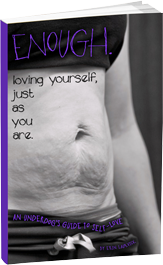In my life, I have set goals no less than one hundred thousand times.
That sounds like an exaggeration, but I’m not kidding. One hundred thousand times. At least 33 years, times 365 days, times 10 goals a day. That’s at least 122,275 goals in my life. (and yes, i did the math. i heart math.)
I was born a chronic overachiever perfectionist. And, like most overachiever perfectionists, goal setting is in my nature. I set goals for EVERYTHING. How much I’m going to eat, and by when. How much I’m going to weigh, and by when. How many workouts this week, and how much weight for each exercise. How many books I’ll read this month, and what kind of books, and how many words. What classes I’ll be able to take. What grades I’ll get in those classes. What time I’ll get to bed. When I’ll get up. What time the kids will do which things. What I’ll do for a job next year, and how much I’ll make, and when I’ll get my next promotion, and what tasks I’ll complete by when in order to get it.
For most (normal, not control freak, not obsessive) people, that probably sounds exhausting.
To be honest, sometimes even for me it IS exhausting, but it’s what I do. I love goals. I live for and through my goals.
And really, setting goals isn’t just great for me, it’s great for everyone. It’s how we get shit done. And, as it is for most people that set goals, we use our goals to launch us forward. To PUSH us. To make us better than we were before, and to drive ourselves to the very edge of our potential.
When I first started in business and management, I was overjoyed to learn that setting goals is not just a good thing, it’s vital. I took to management like a duck to water, mostly because what I did for fun, I got to do at work. Working for corporations with shareholders and IPOs and board members and bosses gave my innate passion for goal setting an outlet, and BOY did I use it. I learned the ins and outs of goals, and how to speak “goal language.” I learned about objectives, tactics, methods, principles, culture, strategy. I learned about S.M.A.R.T. goals (Specific, Measurable, Attainable, Relevant, Time sensitive), and what made goals great, and how to keep them from being pointless.
Mostly, when setting goals for big business, I learned that my correlated tendency to “GO BIG OR GO HOME” was ALSO valuable. I wasn’t just setting goals, I was setting BIG ones. The bigger the goal, the bigger the delivery, the bigger the paycheck. I was rewarded for my ambition, bloodthirst, and (let’s be honest) INSANE, innate, overachiever perfectionist drive.
It’s not JUST me. That’s how we’re all taught to set goals, right? BIG. And meaningful. When we talk about setting goals, we talk about moving forward, toeing the edge of our potential, and making tsunami size waves. When we talk about setting goals, we are talking about going farther. We’re talking about pushing ourselves to finish something, to do more than we’ve ever done, and to succeed. People either take life by the throat, dream big, set goals, and move as far forward as they can, or they SIT. And wait. And let life take them where it will, and they just kind of “exist.” Breathing and eating, using up resources until time snuffs out their already-waning Spark.
No one wants THAT.
So yeah, I’m good at setting goals. I’m REALLY good at setting big goals, and crushing them like crunchy grapes. I am great at “going big or going home,” and I have accomplished quite a bit in my 20-ish years of adult life.
WHY OH WHY, THEN, CAN I NOT HIT MY DIET AND EXERCISE GOALS EVEN ONE TIME, AND WHEN I DO GET EVEN REMOTELY CLOSE, WHY DO I BACKSLIDE.
EVERY. FREAKING. TIME.
When it comes to diet and exercise, it goes like this.
Set a great goal. Get most of the way there, derail. Feel like a total failure, “because derailed, because birthday-party-holiday-late-night-movie-night-date-night-girls’-night-donuts-at-work-p-week.” Stay off the rails for at least two days, then stop trying. Feel bad for quitting, because “I know how to get shit done, WHAT THE HELL, SELF.” Rethink situation. Evaluate all obstacles. Set new goal, apply Self logically and systematically to new goal. Allow emotional upheaval and eat-all-my-feelings-binge take over, for no specific, fathomable reason. Feel furious. “I’m smart, damnit, I can do this, what is my problem.” Set a new goal. Get most of the way there, see a lot of progress, relax a little. Forget I had the goal. Realize when my pants get tight again that I forgot to keep going. Feel angry at tight pants. Feel self-loathing, self-hatred, weak, irrelevant, idiotic, impatient, angry. Set a new goal. “DAMNIT THIS TIME I WILL.” Eat right on target every day for two weeks. Get great exercise. See solid progress. Experience some other life crisis, distraction, or obstacle (job, family, flu, vacation, drama, relationship, house, car), completely shelf goal “because I just have this other thing I have to take care of, I’ll get back to it in just one tick,” forget about shelf AND goal AND tick. Realize six weeks later that “I haven’t been to the gym in a while, and this is the second time this week I’ve eaten a whole pizza for dinner.” RAGE. Frustration. Irritation, anger. Hopelessness. Helplessness. Cold, rigid, self-imposed mental prison with invisible bars, because “WHAT IN THE HELL IS KEEPING ME HERE, WHY CAN I NOT MOVE FORWARD.”
Sound familiar?
Yeah, me too. THIS IS MY LIFE. This is the life of a disordered eater, a behavioral addict, a mother of three, a single mom supporting her family, a woman that works three jobs, a woman that works from home, a codependent that cannot cope with emotional upheaval, and every other person that I’ve spoken to that just. can’t. stick. to. the. plan.
WHY CAN’T WE STICK TO THE PLAN.
After a lot of thought on the subject (and no less than 2458 failed attempts to eat better, find balance, and lose weight), I realized something.
The very same character traits and tendencies that make me so successful at setting and accomplishing big, hairy goals are counterproductive to sustainable, permanent change.
Think about it. For big, giant, conquer-the-world goals, we need just a few things.
- Non-negotiable, inflexible, relentless focus. THIS WILL HAPPEN. No matter what.
- Decisive aggression. Come hell or high water, we are going to get this done, no matter how much we have to break ourselves to get what we want. Too much to do and not enough time? No problem. I can survive at least a month with almost no sleep and just one meal a day. Pee breaks are for wussies. Slip one hand around the goal’s throat, cup the other hand around the goal’s nuts, and SQUEEEEEEEEEZE.
- Sacrifice. The only thing that matters is this big, hairy goal. Nothing else. All other things slide to the side until this is done.
- An endpoint. Every big goal has a drop dead date. Corporate buyout done by this date. House construction done by August 5. Manuscript to editor by May 5.
If a person were to aspire to …well, ANYTHING big, applying these four tactics will definitely get results. Even if they were to fall short of the mark, their efforts are so big and so intense, they would still produce progress and results. I’ve used those tactics myself, more times than I can count. In fact, I am particularly good at tactics number two and three. “Hell hath no fury like a control freak getting her own way,” and I DID. OFTEN.
The problem is, when it comes to small, sustainable, permanent change, every single one of those tactics will curl back around and bite you in the ass. These tactics and this “go big or go home” approach does not work when it comes to diet and nutrition, because each tactic in and of itself is counterproductive.
When framed around small, sustainable change, the above tactics end up looking like this.
Non-negotiable, inflexible, relentless focus. Except you can’t, because life is not just about this one thing. This one thing is not the only or most important part of your short-term life, it is a permanent part of your from-this-day-until-forever life, and the only way to be inflexible is to eat all the things, eat nothing, or plan out and routinely eat like a robot, devoid of emotion or joy. NO THANKS.
Decisive aggression. Aggression is fine, but only for a little bit, and the goal is to eat and exercise because it’s part of your culture, not because you’re pissed. If you have to get worked up and angry in order to do the thing every single time, that’s not living. AND, at some point you will forget why you were angry and doing the thing in the first place. Anger and aggression are great, but they have a shelf life.
Sacrifice. Kind of a “duh,” but a tactic commonly applied to almost every single diet and nutrition program on the market. Every single diet plan expects you to give up something in order to be successful. Every single one. BUT, if you have to sacrifice more than you gain in order to maintain the change, the change is not sustainable. Period. If your diet or exercise plan requires you to give up the things you love, your favorite foods, time with your kids, your social life, holidays, get togethers, business luncheons, or anything else that is part and partial to the ins and outs of life, which do you think is going to go byebye first? Your life? or the change that’s requiring you to die a little inside every time you act on it.
An endpoint. Of the four tactics to crush big, hairy goals, this is the one most detrimental to sustainable change. THERE IS NO ENDPOINT FOR PHYSICAL HEALTH, NUTRITION, AND FITNESS. Well, there is, but it’s an eight-foot-deep hole in the ground and a satin-lined pine box. In real life, as long as we’re breathing, there is no endpoint to the health we seek. We like to assign endpoints, because we use that endpoint as leverage, but even those endpoints are false. “I want to lose 20 pounds before I go to my high school reunion.” “I’m getting married in 5 months, it’s Bridal Boot Camp time so I can fit into a size 8 dress.”
….okay, but then what?
Well, then you’re back to where you started, you’re derailed and frustrated, and you’re yanked back into the cycle of diet-fail-repent-rally-repeat.
I don’t know about you, but I’m tired of it. I’m SICK OF IT.
We’ve been taught in our go-get-’em culture to GO BIG. We’ve been taught that to amount to anything worth anything as a human being, we must drive ourselves as hard as we can to be the best we can be, always (of course) according to societal expectations and “what will everyone think of me if I don’t have a great job-house-family-car-life?”
I think that going big is great, but I think we’re missing something. To create serious, healthy, balanced, sustainable change, we’re missing something.
We’re missing the OTHER kind of goal, not the “go big” one, but the other one. Because the truth is, there are TWO kinds of goals to serve two different purposes, and we need both.
Using Go Big Goals to accomplish big things is great. It’s awesome, and I endorse it fully, EXCEPT. Using Go Big Goals to accomplish small, sustainable change is like handing a three year old a fire hose when he asks for a drink, and telling him “YOU JUST REALLY GOTTA WANT IT.” Ridiculous, right? No matter how bad that kid wants a drink, he’s set up for failure and will probably get himself hurt. No matter how bad YOU want to lose weight and be healthy, approaching your weight loss with Go Big Goals will set you up for failure, and will probably just get you hurt.
To accomplish a small, sustainable change, to make that small change permanent, we need a different kind of goal, with completely different tactics. I call this type of goal a Hold Up Goal.
A Hold Up Goal is just what it sounds like. It is a goal that is set to hold me up a bit while still moving forward, to prevent burnout, and to keep me from blowing all of my energy and focus at once.
I suppose this type of goal could be frustrating or hindering to some, but that’s kind of the point. I need holding up. I need a constant reminder that “it’s not about going big, SLOW DOWN, we’re not interested in going 200 mph in second gear, we just need to crawl along, HOLD UP. Hold back, reign it in. Just wait, and slow down.”
The tactics for a Hold Up Goal are similar but opposite to those of a Go Big Goal. They look like this:
- Negotiable, flexible, patient focus. THIS WILL HAPPEN, all in good time, and as it fits in the normal ebb and flow of life. My plan for healthy is so important that it will become woven into the foundation of my life, not as primary focus, but as an ever-constant culture.
- Decisive, peaceful progress. Come hell or high water we are going to get this done, but there is no need to break ourselves to get what we want. This process is one of calm and steady effort, a tiny bit at a time, with the understanding that “two steps forward, one step back” is still progress in the right direction.
- Balanced sacrifice. If I love something, I keep it. If I want cake, I have some, just not ALL. If I want to sleep in and miss the gym, I can, without shame, guilt, punishment, or need for repentance. Every day is a new day, and all days balance toward progress.
- There is no endpoint. What does not get done today can be done tomorrow. There is no end to “healthy,” and this process is a journey for the sake of the journey, not a relentless drive to arrive at any particular destination. The pace of the journey may vary along the way, but we move always forward, always better, always onward.
Pretty great, huh? I thought so too.
[I can hear you now. “Yeah, that sounds great, but how does that help me? You just listed how to set a Hold Up Goal, but I have no idea what that looks like, or how to practically apply it.”]
Well, I can show you. And HI by the way, I haven’t heard from you in a long time!
To set a Hold Up Goal with regard to diet, exercise, and nutrition, I ask myself just one question.
“How does the goal feel?”
Let’s say I want to exercise and get in shape. I know it’s something I should probably be doing because my pants are getting tight, I’m tired and cranky, my sex life has all but disappeared, I do not feel pretty playing kissyface with the lights on, and I struggle to focus at work. I know that exercise will help me, and I’m feeling a bit urgent to make some change, so I get a gym membership and plan out twelve weeks of intensive training. “I will be in shape in three months, damnit, I JUST DECIDED.”
“Go big or go home,” right?
Yes, but NO. Stop. Think about the goal, think about your reason for doing it, allow all your emotional motivation to fuel the decision you’ve made to join the gym and work out, think about the plan you put together, but then STOP. Breathe, and ask yourself the question.
“How does my plan feel?”
The desire to get in shape? Great. Excellent desire.
The goal to get in shape by following an intense, twelve week plan, after being Captain Couch Potato for the last ten years? “GRRRRRRRRRRRRRR!!!” BIG GOAL. It claws at your guts, makes you want to go go go, pushes you forward, demands attention and umph and POWER. The thought is hugely stimulating, and you can feel the burn in your guts and heart. BIG HAIRY GOAL MONSTER, RIGHT IN MY TUM. BRING IT, WORLD.
The goal to get in shape over the next six to twelve months, combined with the intention to STAY in shape, accomplished with moderate exercise and small, persistent, progressive dietary changes from now until I hit my sweet spot?
“Meh.”
PERFECT. That is exactly the emotional response we want.
A Hold Up Goal, for me, feels “meh.” When I think about it, I think “yeah I could do it, that seems do-able.” There is no fire, there is no time stamp. There is no demand for huge action or over-the-top change. There is only one small baby step, then another when I’m ready, then some more after that. No angry passion, no fury, no throat-or-balls-of-life squeezing, just doing.
The next time you have to set a diet and nutrition goal for yourself, the next time you consider changing your eating habits or your exercise routine, the next time you think “MAN, I really need to start doing more for my health,” STOP. Breathe. Wait a second, think about what your overall goals are, make a plan, and then ask yourself “How does my plan feel?”
If your plan makes you feel compelled to drop all the things, run to the store, fill your cart with organic food and produce, then meal prep the next sixty days all at one time while lifting dumbbells and squatting in the kitchen, maaaaaaaaaaaybe it’s too much. It sounds like you’ve given yourself a Go Big Goal, and although it will definitely get you results, it will likely not get you sustainable ones.
If your plan makes you feel “…meh, that’s good. I’ll add kale to my grocery list and schedule an appointment with a trainer,” PERFECT. You’ve likely found a great Hold Up Goal, one that is small, sustainable, and potentially permanent.
Teeny, tiny baby steps. Small, sustainable change. You can do it, and you can KEEP doing it,
one Hold Up Goal at a time.
==========================================================
Subscribe to the RSS feed, and join in the Depth revolution. Thanks for reading!











Comments ( 0 )